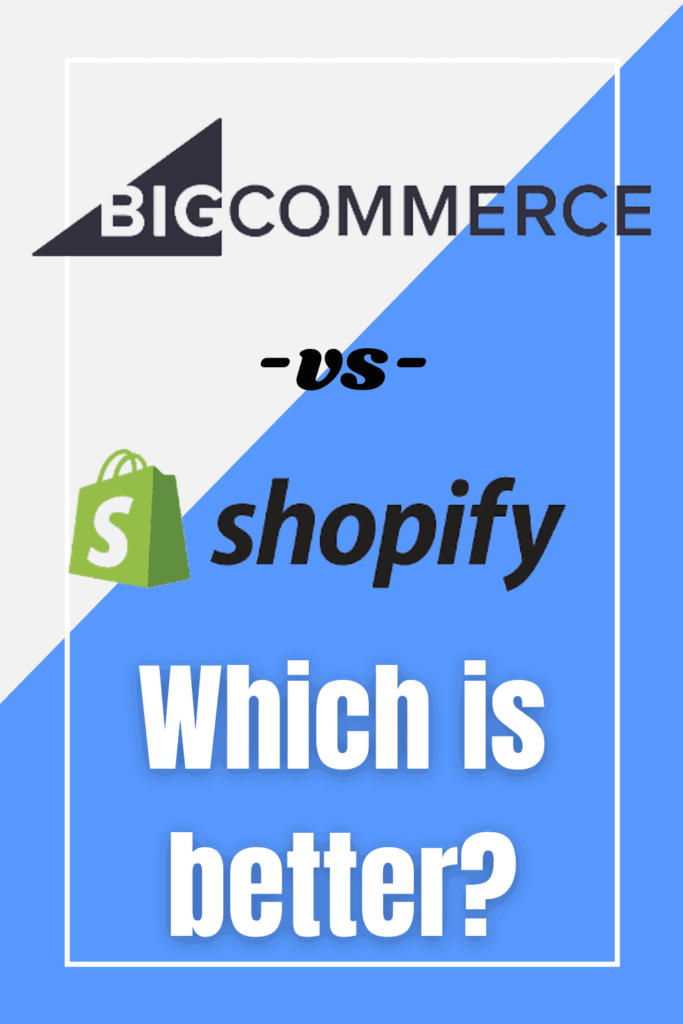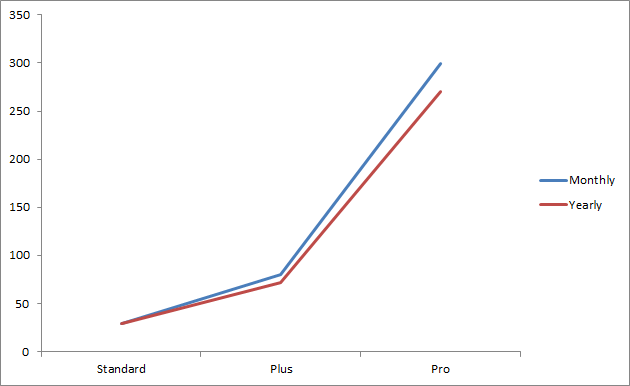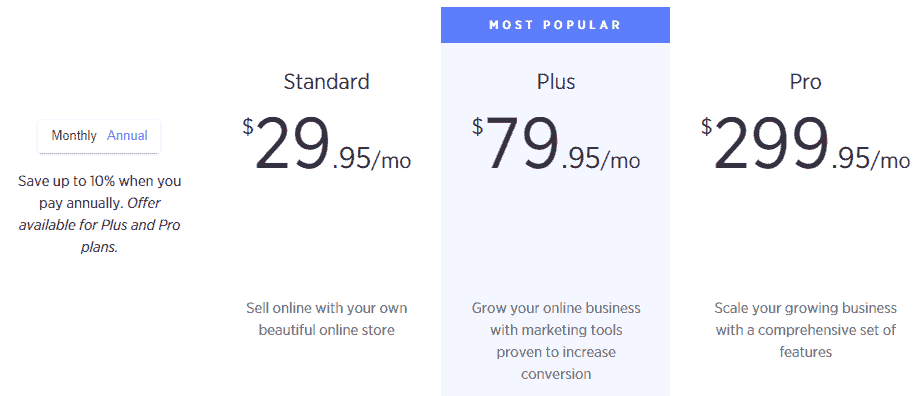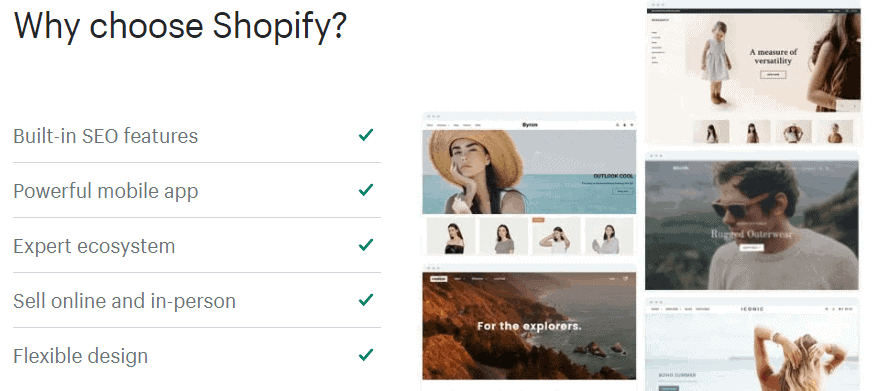The e-commerce market is largely dominated by two primary contenders—BigCommerce and Shopify.
However, despite the preferences of a multitude of users across the globe, each of these websites is embraced by business owners with their perks and traits respectfully.
The question remains, which is better—BigCommerce or Shopify? A question elaborated upon quite vividly, and detailed, for your information below.

- BigCommerce and Shopify—What are they and what are their Primary Functions?
- Pros and Cons of BigCommerce and Shopify
- How do the backgrounds compare? BigCommerce vs Shopify
- History Timeline—BigCommerce vs Shopify
- BigCommerce Vs Shopify Pricing Plans and Strategies—Who Comes Out on Top?
- Value for Money—Shopify or BigCommerce
- Ease of Use—How do they Measure?
- Sales Features—Which One is Better?
- Marketing features—BigCommerce vs Shopify?
- Designs—Who Appeals Better to the Modern Eye?
- Shopify Plus vs BigCommerce Enterprise for Large Businesses—Which is The Best?
- Hosting, Uptime, Security, and Support—Which Ranks Better?
- Final Conclusion—Is Shopify the Better Contender, or BigCommerce?
BigCommerce and Shopify—What are they and what are their Primary Functions?
Before the two platforms are compared, it is noteworthy to establish what BigCommerce and Shopify basically are.
Within the online ecosystem, BigCommerce and Shopify are prevalently building tools for websites. Once constructed, these website builders permit the selling of various products, digital and physical, within the online sub-spaces.
[wptb id=347]
The products showcased by business owners, or simpler users, function via a web browser which primarily entails the usage of BigCommerce and Shopify without the installation of software on a laptop, mobile phone, or whichever device a user chooses to operate their store from.
More importantly, given that a user has a stable internet connection, BigCommerce and Shopify can be managed from any location worldwide.
In short, it provides users with a means to establish an online buying and selling platform without the need to be equipped with knowledge of design, coding, or generic technical skills required to develop web stores otherwise.

In essence, using BigCommerce and Shopify is as simple as choosing a template from the adventure section, proceeding to upload the products you wish to sell, and determining and setting your prices.
After the following, users are open to indulge in the market space quite frivolously.
And yet, despite the easygoing provisions of both BigCommerce and Shopify, users do require quite basic skills.
This is because regardless of the fact that one does not require a web designer when construction of their store is ongoing, an eye for attractive design, alongside the possession of adequate, high-quality photographs, are vital in the establishment of prominent results with each, or either, of these websites.
Moreover, BigCommerce and Shopify are SaaS tools within the technological workspace.
As such, these are ‘Software as a Service’ tools enabling users to utilize them with a continuous cost; users may either be charged by the month, or annually, to gain constant access to these website building platforms.

In order to better equip readers with a thorough recognition of which tool is better, or best suits their needs, the elaborations below are based on everyday testing by ourselves, and various, specific groups of people.
After detailed analysis, comparisons, and examination, MoneyMintz brings to you the following information.
Ranging from sales features, pricing strategies and plans, access to customer support, and designs and user interfaces, our research is exhaustive and covers the very essential to best equip you with an understanding of BigCommerce and Shopify.
Pros and Cons of BigCommerce and Shopify
Before divulging the specifics of these platforms, a basic summary of their pros and cons will help guide readers through the comparisons made later on. A quick read of the pros and cons, before deciding in actuality whether you would want to pick BigCommerce or Shopify, is certainly beneficial.
Similar to the likes of multiple eCommerce construction tools for websites, BigCommerce and Shopify too greet users with a flurry of very prominent positives, coupled with a few negatives to dwell over.
To begin, let’s first consider Shopify.
The Pros of Shopify
The Cons of Shopify
Moving on from Shopify, let’s dwell upon the basic pros and cons of BigCommerce
The Pros of BigCommerce
The Cons of BigCommerce
How do the backgrounds compare? BigCommerce vs Shopify
Readers might be wondering why, out of the many E-commerce platforms within the digital market of today, have we chosen to focus on BigCommerce and Shopify. Quite simply, despite the presence of many other such platforms, these two rank much higher than those present within the same sector. The purpose of this production is thus, to narrow the basis of similarities, and polarities, between the two in order to recognize the more superior one.
Simplistic to use, riddled with an impressive range of features, and projecting prices unmatched within the industry, Shopify and BigCommerce reign supreme. However, their individual backgrounds of establishment produce an interesting array or facts which might insinuate a user’s selection or one over the other from the start itself.
History Timeline—BigCommerce vs Shopify
Let us see the History Timeline of BigCommerce and Shopify. The History Timeline shows the major milestones these companies have covered in reaching to what they are known today.
Shopify History Timeline
Shopify was founded in 2006, with the setting of their headquarters in Canada, more specifically in Ottawa. Over time, the company is well identified as amongst the biggest, and fastest, growing companies within the technological industry.
Today, Shopify proudly announces a workforce powering over 600,000 retailers on an online platform, while they further boast of a growing number as each day passes. Shopify further possesses outstanding reviews.
2004
Shopify was then named Snowdevil, an online store, selling snowboards.
It was later named Jaded Pixel when it first started as an e-commerce platform.
2006
In June 2006, Snowdevil founders, Tobias Lütke, Daniel Weinand, and Scott Lake launched an e-commerce platform known as Shopify.
2009
In June 2009, Shopify launched API platform for developers to create applications and sell them on Shopify App store.
2010
Ottawa Business Journal named Shopify as Ottawa’s Fastest Growing Company.
Company received $7 million Series A funding in December 2010.
2011
In October 2011, Shopify raised $15 million in Series B funding.
2012
In February 2012, Shopify acquired Select Start Studios Inc, a mobile software development company.
2013
In August 2013, Shopify acquired Jet Cooper, which was a design and user experience company based out of Toronto.
Company raised $100 million in a Series C round of funding.
2014
Shopify had more than 80,000 customers with $1105 million in revenue in 2014.
Shopify Plus was released.
2015
Shopify went public on May 21, 2015, raising $131 million in IPO.
In September 2015, Amazon migrated its Amazon Webstore to Shopify which caused Shopify shares to jump by 20%.
2016
Shopify acquired Boltmade, Frenzy and Tiny Hearts.
2017
On May 11, 2017, Shopify acquired Oberlo for $15 million.
2018
Shopify was used for online cannabis sales in Ontario as the drug was legalized in October 2018.
2019
Handshake was acquired by Shopify. Glen Coates, founder of Handshake was made Director of Product for Shopify Plus.
Announcement of the launch of Shopify Fulfilment Network.
2020
In November 2020, Shopify partnered with Alipay to improve cross-border payments.
BigCommerce History Timeline
Unlike Shopify, BigCommerce isn’t quite as dated, and was founded three years later than the former. Beginning with their original basis in Sydney, Australia, it was founded in 2009, after which their primary headquarters have been relocated to Austin, Texas. Yet, despite the shift of their corporate headquarters, Australia continues to be a location where the larger number of their employees reside.
BigCommerce’s consistency is visible through their growth trajectory, whilst they serve online stores across the globe in a number they claim to be 100,000.
2003
Interspire, an email marketing company was launched in Sydney, after a chatroom meeting between Mitchell Harper and Eddie Machaalani.
2009
BigCommerce was created from Interspire and relocated to Austin, Texas.
2011
BigCommerce received $15 million in Series A funding.
2014
In February 2014, BigCommerce opened its office in San Francisco.
2015
In April 2015, BigCommerce acquired Zing.co, a mobile retail technology provider company.
BigCommerce Enterprise was launched.
2016
In March 2016, a new corporate brand identity of BigCommerce was unveiled.
In September 2016, integration with Amazon was rolled out.
2017
BigCommerce collaborated with Instagram to help its users sell products online.
2018
In April 2018, Make It Big, BigCommerce’s first brand campaign was rolled out.
In May 2018, BigCommerce raised $64 million in Series F funding from Goldman Sachs.
2019
In February 2019, BigCommerce started operations in Singapore.
2020
In July 2020, BigCommerce filed for an IPO.
Where it concerns their growth factors, Shopify has experienced a meteoric rise within the market space and factually does attract more clients than BigCommerce. Yet, it is important to note that these two companies, although both residing within the e-commerce industry, cater to different types of users who seem to thoroughly relish the services provided by each.
BigCommerce Vs Shopify Pricing Plans and Strategies—Who Comes Out on Top?
Let us now talk about BigCommerce Vs Shopify pricing plans and strategies, as this is a major factor in customer acquisition. Quite notably, when a user decides to employ the tools provided by website builders within the e-commerce sector, the monthly charges of doing the same may very well be the deciding factor between companies such as BigCommerce and Shopify.
Setting aside the monthly cost, users will also have to factor the transaction fees, and credit card fees (or other such additional costs) within their budget.
To expand upon the same, the following will first cover the monthly prices as per the plans, after which the additional costs posed by BigCommerce and Shopify will be elaborated upon.
BigCommerce vs Shopify Pricing Comparison Summary
Each of these platforms offers users pricing plans of the same amount, which is three. Alongside these pricing plans, BigCommerce and Shopify both offer a discount of around, or up to, 10%, if users decide to pay by the year, instead of making payments monthly.
The pricing plans of BigCommerce typically allow users to pick between a plan beginning with $29.95/month, to $299.95/month being the priciest, coupled with a medium ground of another plan. In contrast, Shopify has very similar pricing for its users, with the lowest plan being that of $29/month to $299/month.
Apart from this, Shopify, unlike BigCommerce provides users with an option called ‘Lite’. For $9/month, users are permitted to place a Shopify button which allows them to utilize a shopping cart widget within their already existing website. This is quite similar to the ‘Buy Now’ button when making use of PayPal.
Thus, when illustrated, the plans offered by Shopify and BigCommerce for online stores come across as such:
| Standard Plan | Medium Plan | Advanced Plan | |
|---|---|---|---|
| Shopify | $29.00 | $79.00 | $299.00 |
| BigCommerce | $29.95 | $79.95 | $299.95 |

Graph: Graphical Illustration of Shopify Pricing Plans
You can click on the blinking hotspots to check the details of Shopify Monthly Pricing Plans.
You can click on the blinking hotspots to check the details of BigCommerce Monthly and Yearly Pricing Plans.

Graph: Graphical Illustration of BigCommerce Pricing Plans
Amongst these, both platforms further offer much larger companies more expensive, but unique and tailored to their interests plans. These are called BigCommerce Enterprise and Shopify Plus, which will be discussed as we proceed.
Therefore, given the very close numbers provided by BigCommerce and Shopify, the prices appear quite similar when first viewed. This is where the additional costs factor in to really pose a difference.

Beginning with Shopify, if users were to sign up at once for a whole year, they would be provided with a 10% discount post their subscription. Moreover, a subscription of two years would allow users to enjoy a 20% discount, which essentially means the Shopify pricing plan allows business owners, companies, or individuals, to save close to $200 as each year goes by.

Additional Costs: Transaction fees, and Credit Card Fees
Transaction fees
First, users must be aware of what a transaction fee is. A fee of this kind is basically the revenue percentage that is taken by website builders upon every sale made by those utilizing the services of the website building platform.
BigCommerce, and this would enlighten several readers, takes no transaction fees from users for any of its plans, regardless of how they may be priced.
However, Shopify, differs from the former in this way. Depending upon the pricing plan chosen by a user, Shopify charges between 0.5% to 2%. There is a way for users to avoid this, but it can only be done by the usage of Shopify Payments, instead of other processors for your payment such as PayPal.
This was one of the cons listed earlier, with regard to Shopify, as well.
Credit Card Fees
Transaction fees are operational between the e-commerce platform being utilized and the user, while credit card fees are the payments made to payment processors, like PayPal, which are utilized by users when making sales.
BigCommerce permits users to benefit from more than 65 of such integrations, while Shopify offers more than 100 of the same.
Thus, users will be happy to note that there are ample payment processors to divulge in.
BigCommerce and Shopify also tend to recommend certain payment processors to its users, from which users will benefit from special rates.
Shopify undoubtedly recommends the Shopify Payments option, which is an in-house payment processor.
On the other hand, BigCommerce recommends PayPal—a very popular, and widely utilized, payment processor.
Both Shopify Payments and PayPal charge users a credit card fees of 2.9% + 30 cents on every transactions made.
Value for Money—Shopify or BigCommerce
Since we’ve seen that the prices between BigCommerce and Shopify aren’t quite different, the primary comparison narrows down to the features and tools, offered by each of these platforms.
Bigcommerce offers a free trial for 15 days, while Shopify offers a free trial for 14 days.
However, Shopify relies more on third-party applications than Bigcommerce does, which implies that BigCommerce provides more tools in the cost when utilizing their online store.
One of these includes a function of a built-in tool that lets you drag and drop items within the website editor. Users can insert content elements onto any page with ease.
In comparison, Shopify allows users to do much the same but using a separate app. For example, if users were to drag and drop elements of Shopify, they would have to use an additional app such as Buildify. An app like this would come at a further cost of $12.99/month.
Concluding Remarks on Pricing?
Both the platforms offer competing prices, and yet, BigCommerce certainly offers users more, and better value, for their money than Shopify does. The built-in tools, alongside the absolute lack of mandatory transaction fees, clearly declare it the better contender, at least in this regard.
Ease of Use—How do they Measure?
The statistics depict BigCommerce and Shopify as platforms that both utilize a direct, and manageable, management system for their content. Secondly, both platforms further possess a modern dashboard and a website editor which is effortless and straightforward to users.
In addition, each of these website builders is efficiently formatted, whilst consisting of a multitude of useful pointers and tools.
However, users were noted as stating that, despite the many similarities, Shopify was still 21% simpler to use in comparison to BigCommerce. This was said to be because BigCommerce possessed features that are, with regard to Shopify, more advanced and scalable. In turn, this makes it less adequate and not as easy to use for beginners.
Shopify – Shopify, though more suited to the every-day man, also provided their users with several tools. Shopify does this by permitting users to add products in an efficient, cost-effective, and speedy manner, by filling their details onto a form for individual items.

BigCommerce – BigCommerce, in comparison to Shopify, offers users more advanced, and powerful, features for the selling of their items. Thus, the utilization of this software may require additional learning by the user.
Beginning with the primary ‘Product Information’ window itself, the number of factors initially visible to a user appear worrying, difficult to navigate, and often come across as widely unfamiliar.
However, if a user is willing to understand the database, customers of BigCommerce will find themselves more appreciative of the larger diversity of categories, coupled with the hands-on information in the BigCommerce store.

In recent years, upon feedback of several users, BigCommerce has further worked upon its settings to allow users easier access to their tools.
As such, in comparison to Shopify, BigCommerce’s builder to drag and drop items outperforms that of the former with regard to the flexibility of its design.
Users now simply have to select the desired element from a page, and proceed to insert it wherever they choose to do so.
Storefront designs, thanks to BigCommerce, have now been modified into a simple process while utilizing its editor. Even though users can switch the order of their page element with Shopify, they would have to do so through the operating of a list, rather than simply dragging and dropping elements.
Concluding Remarks on Ease of Usage?
Quite evidently, Shopify appears much easier to utilize than Bigcommerce, making it the optimum destination for beginners and advanced users alike. BigCommerce, although quite powerful, is certainly not ideal for beginners or business users new to the digital e-commerce industry.
Sales Features—Which One is Better?
According to research done by various technical blogs and researchers, quite straightforwardly, Shopify appears to be the better contender when it comes to sales features. BigCommerce of course comes in straight after. Drawing similarities between the pair, BigCommerce and Shopify share the standard features deemed essential for such platforms:
- They both offer selling across multiple different social media platforms, namely Instagram, Pinterest, and Facebook. Thus, the multichannel selling options are quite beneficial to users.
- BigCommerce and Shopify stand together in their provision of printing shipping labels particular to users, unique options to ship locations, and rates as per the order value or weight of the shipments.
- Once again, both these top contenders within the e-commerce industry possess SSL certificates, namely the Secure Socket Layer certificate. This essentially provides protection to online users and deems the online market place as a secure place to process the different online payments of users.
However, the features listed above are near mandatory for any prominent e-commerce platform today. Thus, enlisted below, are the features that cause polarities between BigCommerce and Shopify.
- Access to Top Built-in Features:
Massive sales features are embedded within BigCommerce Store. It enables easy and faster installation. - Reviews and ratings by Users:
Product Reviews features are in-built in BigCommerce, which Shopify provides through external apps. - Shipping Quotes in Real-Time:
This feature allows customers to receive adequate information regarding the shipping of their products. - Staff Accounts:
BigCommerce allows its users to grant multiple accesses to a variety of staff members as a site admin.
Moreover, a variety of other features come along built in with Shopify and BigCommerce both. However, these are indubitably far more advanced within BigCommerce.
An example of the same is the fact that Shopify offers users around 100 variants of each product (relying on the material, color, and size), while Bigcommerce offers close to 600 options for the same. Thus, the management features within the inventory are more impressive where it concerns BigCommerce, in comparison to Shopify.
Moving on to Shopify, despite falling slightly short with the inventory management features, Shopify does have its own advantages. This is particularly true of its customizable features.
- Plenty of Tools:
Shopify offers users thousands of tools to engage with in their App Store. Even though this requires more effort to do than BigCommerce, it is simple because the store is considerably much larger than BigCommerce’s. A few of these tools namely are the booking forms for appointments which are quite personalized, alongside the pickup option by one’s curb. - Option to Select Free or Paid Tool:
Although not included in the monthly cost of the plans provided by Shopify, some of these plugins do cost users anywhere between being absolutely free to $200. However, despite the prices, the apps are particularly suited to e-commerce stores across the globe.
Concluding Remarks on Sales Features?
Shopify provides users with an array of customizable features, whilst, BigCommerce is inclusive of features that are efficient and widely utilized from the beginning itself. Thus, it would largely depend on the requirements of a user and as such, one really isn’t better than the other and comes with its own advantages.
Marketing features—BigCommerce vs Shopify?
As stated earlier, Shopify has a larger variety of options within their store, yet, BigCommerce has a larger gallery of features that are built into its platform. Thus, how do they compare where it concerns their marketing tools?
- The creation of discount codes efficiently for the usage of shoppers.
- Title tags, metadata to urge only the best SEO practices, customizable URLs, and site maps in the automatic frame.
- Reporting tools that are quite professional.
- Shopping integration by utilizing one-click google.
Alongside these, the plans offered by BigCommerce are more advanced along with segmentation tools to aid users to have a shopping experience more suited to their personal needs. BigCommerce additionally provides users with the ability to send customers an automatic abandoned cart email so they may recover the items in their shopping cart at checkout.
- Finance summaries and the performance of products can be divulged in to with the Shopify analytics options
- Gift cards and discount codes can be created
- Headers, customized URLs, and automatic sitemaps are provided to users
However, regardless of these tools, users can still enjoy a degree of insight into their product performance with the basic plan offered by Shopify. Yet, it doesn’t come with quite all the analytics users might desire. Thus, users would often have to upgrade to the more advanced plans offered by Shopify if they were to utilize profit reports and sales data.
Concluding Remarks on Marketing Features?
Based on the information supplied above, this one would have to come across as yet another stalemate between these two contenders, Shopify and BigCommerce. Both platforms are quite aware of the vital nature of online stores’ marketing features, and they do provide tools they deem fit accordingly.
Designs—Who Appeals Better to the Modern Eye?
Unfortunately, Bigcommerce and Shopify both offer users with a very narrow amount of options when choosing their free themes.
Shopify gives users a choice between nine free themes, while BigCommerce allots users a similar decision with a number of twelve free themes.
Even though BigCommerce’s new drag and drop editor makes customizing and editing its fee themes easier, Shopify’s themes on offer are not as uniform and as such, do not require much editing or even customization.
Free and Paid Themes within Shopify
New business owners who are looking to save, or even businesses looking to minimize their costs, will find the free themes offered by Shopify quite decent. The themes themselves are provided with several variations when choosing one’s layout.
However, businesses with more established brands will find these themes quite outdated and basic; they come across as a poor reflection of larger businesses. Thus, users of this kind will need to opt for the paid themes instead.
Shopify has abundant of free and paid themes. These themes are beautiful, fast, and responsive.
Users have plenty of options to choose from these themes, depending on their needs. Themes range from minimalistic in design to visually striking themes. You can choose these themes depending on your niche.
If you are into apparel design Shopify’s Brooklyn free theme would be perfect to start away with. Likewise, you can go with a theme with more advanced and intuitive features like the Parallax theme. This theme is a paid one and costs a one-time fee of US$180.

There are 9 free Shopify themes and 64 paid themes. A paid theme would cost you somewhere from US$100 to US$180 each. All these themes come with a number of styles for you to choose from.
Here is a list of 9 Free Shopify Themes:-
| Shopify Free Themes | Styles | Description |
| Express | 2 Styles | Perfect theme to go online fast |
| Narrative | 4 Styles | Perfect for storytelling about your products |
| Debut | 2 Styles | Beautiful design to showcase products and brands |
| Venture | 3 Styles | Ideal for large product inventories |
| Boundless | 2 Styles | Minimalist design to highlight your products |
| Simple | 3 Styles | Clean and minimalist design |
| Brooklyn | 2 Styles | Perfect for online apparel store |
| Supply | 2 Styles | Showcase and filter large inventories |
The themes on offer cover a range of industries, such as the hospitality industry, tourism industry, and the food and beverage industry.
Amongst these, Shopify further permits its users to sort their paid themes by layout styles, a number of products, and menu styles based on the desired navigation, amongst others. Moreover, the paid themes can also be personalized to suit one’s online store, while the themes can be switched whenever desired.
Free and Paid Themes within Bigcommerce
Just as Shopify offers a multitude of themes with a one-time payment, BigCommerce offers more than double the amount of themes.

BigCommerce has 12 free themes and around 150 paid themes. The cost for BigCommerce paid themes would range from US$150 to US$300 per theme. For example, Luna Light a premium BigCommerce theme would come for US$300 and Prosper Bold for US$150.
BigCommerce themes are highly responsive and SEO optimised.
Here is a list of 12 Free BigCommerce Themes:-
| BigCommerce Free Themes | Styles | Description |
| CornerStone Light | 3 Styles | Contemporary design for bold brands |
| CornerStone Bold | 3 Styles | Showcase multiple featured collections |
| CornerStone Warm | 3 Styles | Configure your theme to highlight your content |
| Fortune Minimal | 4 Styles | Perfect for stores with large inventory |
| Fortune Bright | 4 Styles | Grid-style theme with bold imagery |
| Fortune Contrast | 4 Styles | Impactful visually striking theme |
| Fortune Highlight | 4 Styles | Enables quick find for your products |
| Vault Bright | 3 Styles | Storytelling theme for premium brands |
| Vault Cool | 3 Styles | Improved user experience with online store |
| Vault Natural | 3 Styles | Contemporary design for visual storytelling |
| Lifestyle Default | 1 Style | Editorial-inspired design perfect for bold imagery |
| Roots Original | 1 Style | Product-focused ideal for visual storytelling |
Whatever your niche is, you are sure to find a theme for it on BigCommerce. The simple drag and drop feature of these themes makes your task of developing a fully responsive online store easy and fast.
Once again similar to Shopify, BigCommerce’s themes offer a range of styles from within different palettes.
You may find users who relish the ample amount of themes at first, however, the many themes are simply variations of the same content. BigCommerce often tends to market the same layouts as four different templates as well.
Concluding Remarks on Designs?
BigCommerce offers a large variety of customization for the themes on offer, more so than Shopify. Yet, Shopify’s designs are vertically more unique.
Shopify Plus vs BigCommerce Enterprise for Large Businesses—Which is The Best?
Where it concerns the provision of services to businesses on an enterprise-scale, BigCommerce and Shopify equally offer notable plans to develop one’s online store with the absolute best support and tools of the most advanced levels. These plans can be purchased via Shopify Plus for Shopify, and Bigcommerce Enterprise for BigCommerce. Each of them strives to assist bigger businesses to reach an optimum level of their online potential within the e-commerce space. The following are the primary comparisons between the two:
- Pricing:
Shopify and BigCommerce make use of bespoke quotes that are tailored to the annual revenue made by a business. BigCommerce prices its quotes, within the BigCommerce Enterprise, within a range of $500 to $15,000 for each month. In contrast, Shopify Plus charges $2,000 each passing month as a minimum. - Calling Frequency:
Users would be able to better sync their catalogs for their products while utilizing BigCommerce for the BigCommerce Enterprise is built to manage around hundreds of calls, API zones, as each second passes. In comparison, Shopify Plus draws a limit at 10 calls within each second. - Features:
Elaborated upon above, the range of tools offered from the start with BigCommerce Enterprise are varied and many, particularly in comparison to those offered by Shopify. However, Shopify Plus is more reliant on the market it offers for apps due to the multiple customizable options it provides users with. As such, because apps typically cost a hefty amount to users, businesses on an entrepreneurial scale could potentially save a stunning $30,000 annually if they were to use BigCommerce rather than Shopify. This is due to the lack of subscription costs for the apps provided by Shopify.
Concluding Remarks on Shopify Plus vs BigCommerce Enterprise for Large Businesses?
Quite evidently, BigCommerce Enterprise appears the more suitable platform for businesses that are much larger than others. Shopify Plus too offers solutions that are quite powerful, coupled with tailored settings. However, since BigCommerce possesses more built-in tools, it is more equipped to deal with large inventories.
Hosting, Uptime, Security, and Support—Which Ranks Better?
Your e-store should be safe, secure, and fast, with the best uptime. Downtime can result in a huge financial loss, damage of reputation, loss of visitors, especially when your website has significant traffic.
Both Shopify and BigCommerce promises some great uptimes of 99.99%.
Both Shopify and BigCommerce have all their stores running on PCI DSS Level 1 compliant servers. They use SSL for an extra layer of protection.
Quite interestingly, whether a user makes use of BigCommerce or Shopify, the following security and support options are available to each user:
Shopify further has useful prompts all across its website dashboard that distinctly relate relevant sections within the knowledge hub of Shopify. It is quite a helpful self-help feature that lets users manage their online stores much better and at their own comfort.
Moreover, for both BigCommerce Enterprise and Shopify Plus, an update to the most advanced plans provide users with priority support. As part of BigCommerce, users have access to a phone support consultant. For Shopify, an agent would support business owners 24/7 in a dedicated manner.
Concluding Remarks on Shopify vs BigCommerce Support, Security and Uptime?
As mentioned above, they are much the same in this regard.
Final Conclusion—Is Shopify the Better Contender, or BigCommerce?
Firstly, whichever e-commerce platforms users deem better largely depends on the services they are looking for. Both of these platforms are stellar contenders offering a varied amount of services across several verticals. However, there are quite a few noteworthy differences which we will quickly skim through once again below.
Therefore, even though the better contender is largely determined as per a user’s requirements, research finds Shopify to be the winner due to the provision of quality customer support, its designs for templates, and the absolute ease of usage for beginners, and advanced users together.
This article on which is better—BigCommerce or Shopify makes a clear distinction between the two, helping you out in making you an informed decision.








